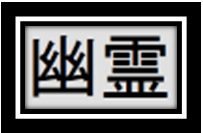To learn much more about Japanese Ghosts, check out my book Yurei: The Japanese Ghost
Yurei—Japanese Ghosts—follow certain rules; obey certain laws. They have a specific appearance and purpose. These rules supply authenticity, making them culturally relevant and recognizable. Also, these rules make them more horrifying than the constantly changing Western ghost, which can be played for laughs, romance, or fear at any given moment.
Each aspect of a yurei is bound by centuries of culture and tradition. There is a “why” behind everything, and the story of the individual aspects of the yurei can be as fascinating as the yurei stories themselves.
Click the title of each to be taken to the full story.
5. How Do You Say Ghost in Japanese?
A country as obsessed with ghosts as Japan is obviously going to have more than a single word. Just as in English, there are several words meaning “ghost,” but each with a different usage and feel.
4. What is the White Kimono Japanese Ghosts Wear?
Black hair. White face. White kimono. Whisper the word Japanese ghost to anyone, and that is the image that will appear in their head. For Americans, the image generally comes from Japanese horror films where white-kimonoed girls crawl from TV sets or rise from wells. But to Japanese people, the costume of a white kimono has a more somber feel. Most likely over their lives they will wrap more than one loved one in the traditional burial garment called a kyokatabira.
3. What is the Triangle Headband Japanese Ghosts Wear?
What are those odd, triangle-shaped hats or headbands worn by some Japanese ghosts? That is a difficult question to answer because, while there are several opinions, nobody really knows.
2. Why do Japanese Ghosts Not Have Feet?
The gentle drops of falling rain. A lonely willow tree standing near a graveyard. And a Japanese ghost, called a yurei, waiting below. This is our image of a yurei, and when we imagine this picture of the yurei, it has no feet.
1. What’s the Difference Between Yurei and Yokai?
What is a yokai? What is a mononoke? What is a bakemono? Are yurei also yokai? These seemingly basic questions have no precise answers. Almost everyone has their own ideas, and they seldom agree with each other. Because folklore isn’t a science.








Feb 23, 2014 @ 20:28:03
Reblogged this on seikaiha’s blah-blah-blah and commented:
Great insights and glimpse into Japanese ghosts and mysteries.